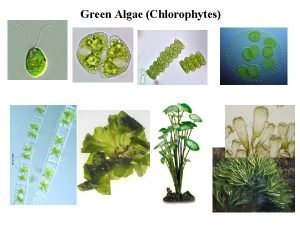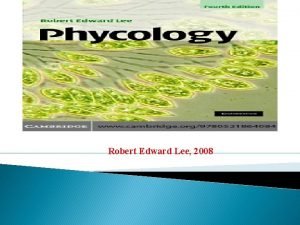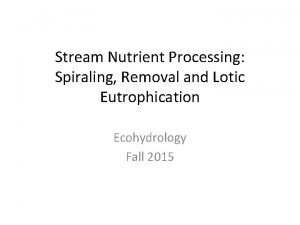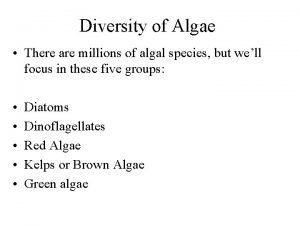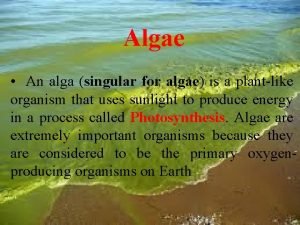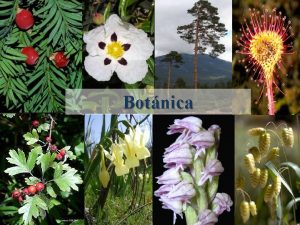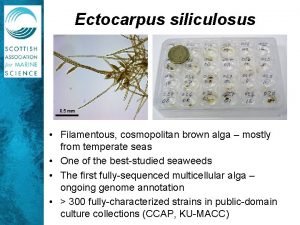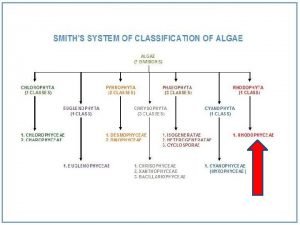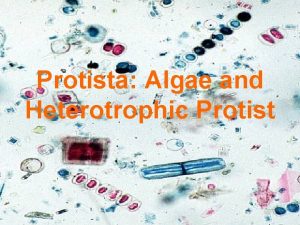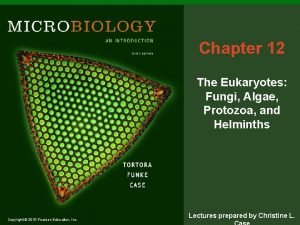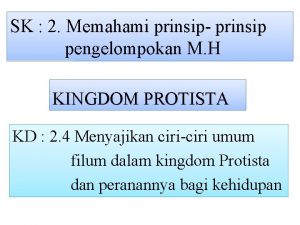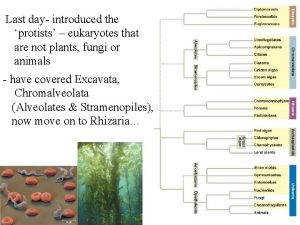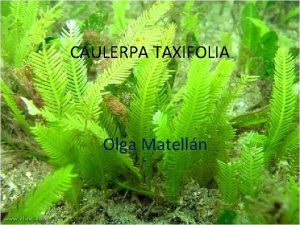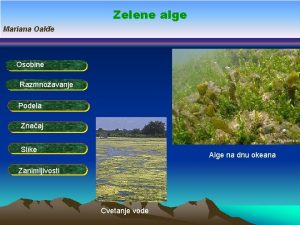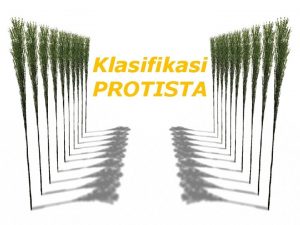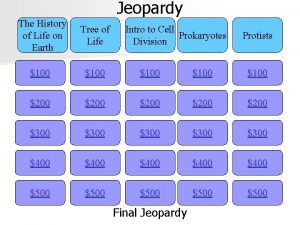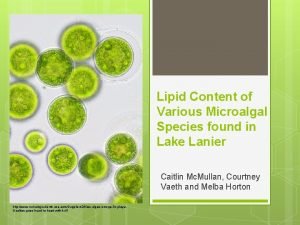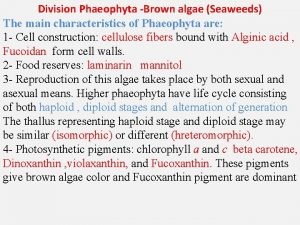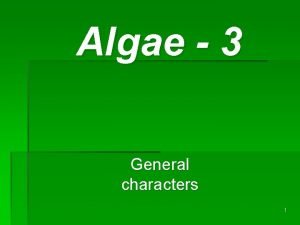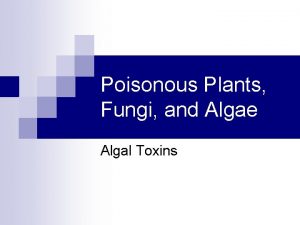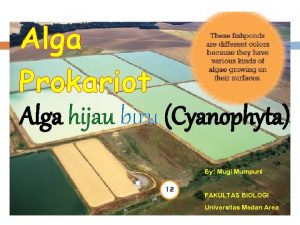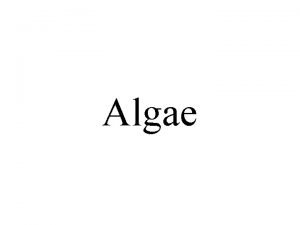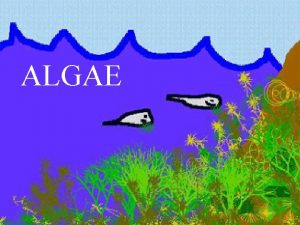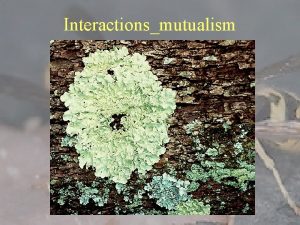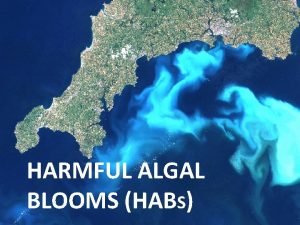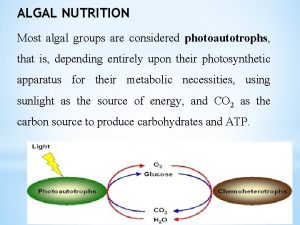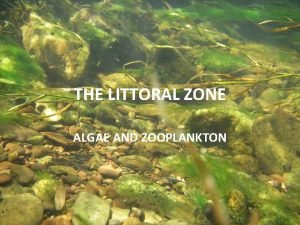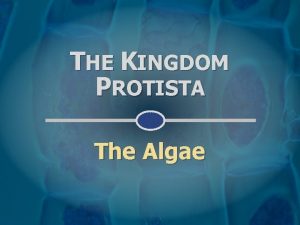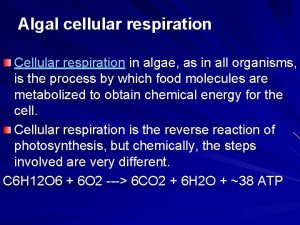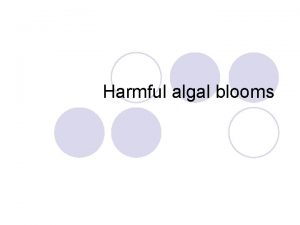Algal physiology What are Algae An alga singular
































- Slides: 32

Algal physiology What are Algae? • An alga (singular for algae) is a plant-like organism that uses sunlight to produce energy in a process called Photosynthesis. Algae are extremely important organisms because they are considered to be the primary oxygen-producing organisms on Earth

Most algae are posses as primary producers , they use the sunlight energy to convert inorganic substances into simple organic compounds. And provide the principal basis of food webs on the Earth. they produce oxygen that is essential for heterotrophic organisms.

Definition • The word "phyco" is derived from a Greek word "phykos" that means seaweed. Phycology is the study of the cells, structure, function, life cycles, ecology and other properties of algae. It is also called algology. • Algae are thallophytic ; their vegetative body is not organized in root , leaf and stems like that of the kormophytes. many algae are living in solitary cells , colonies , filaments , or primitive vegetation bodies and do not have a vascular system. in contrast to the phanerogams (plant producing seeds ),

Therefore its definition is : -Algae are hetrogenous -Very sample -Auototrophic organisms -Having no sterile layer around their reproduction organs -Lacking true embryogenesis

Classic classification: Algae is a hetrogenons assemblage of individuals , being distributed in tow kingdoms : §Monera §Protista §protoctista

• Following a conception of sub division of living organisms into five kingdoms (Monera, protista, fungi, animalia, and plantae). • The prokaryotic algae (Blue green algae , cyanobacteria, cyanoprokaryota) are placed in the monera. the eukaryotic algae are placed in the protista. the algae do not belong to kingdom of Plantae. Nevertheless , it is widely accepted (because of the photosynthesis characteristic )to interpret algae as (lower plants)in distinction to the vascular (higher plants). • The eukaryotic algae Posses membrane –bound organelles such as nuclei, Golgi body mitochondria and plastids. the prokaryotic cyanobacteria do not exhibit such organelles: ; their DNA and photosynthetic thylakoids lie free in the cytoplasm.

Fig 1 a- Drawing of the fine-structural features of a cyanobacterial cell. (C) Cyanophycin body (structured granule); (Car) carboxysome (polyhedral body); (D) DNA fibrils; (G) gas vesicles; (P) plasmalemma; (PB) polyphosphate body; (PG) polyglucan granules; (Py) phycobilisomes; (R) ribosomes; (S) sheath; (W) wall. Fig 1 b- Drawing of a cell of the green alga Chlamydomonas showing the organelles present in a eukaryotic algal cell. (C) Chloroplast; (CV) contractile vacuole; (E. R. ) endoplasmic reticulum; (F) flagella; (G) Golgi body; (M) mitochondrion; (N) nucleus; (P) pyrenoid; (S) starch; (V) vacuole; (W) wall.

How to distinguished algae from plants Algae and plants produce the same • Storge compunds • Use similar defense strategies against parasites and predators • Strong morphological similarity exists between algae and plants • Then how to distinguish ? ? ? ……. . Because similarities between plants and algae are much fewer than there differences 1 -plants show a very high degree of differentiation with root , leaves, stem and xylem /phloem vascular network 2 -reproductives organs are surrounding by a jacket of sterile cells

3 -They have a multicellular diploid embryo 4 -Producing tissue that differentiate in a wide variety of shapes. algae do not have any of these 1 -they do not have root, leaf and stems. 2 - they don’t form true embryo 3 - do not have a vascular system.

Distribution and abundance

Algae are most common in aquatic habitats. They can be categorized ecologically by their habitats. 1 - Planktonic : microscopic algae grow suspended in the water. Euphytoplankton / all the life cycle is plankton Tychophytoplankton / some of the life cycle is Plankton 2 - Neustonic : algae grow on the water surface. 3 - Cryophilic: algae occur in snow and ice. 4 - Thermophilic: algae live in hot springs. 5 -Edaphic : algae live on or in soil. 6 - Epizoic: algae grow on animals, such as turtles and sloths. 7 - Epiphytic: algae grow on fungi, land plants 8 - Epilithic: algae live on rocks. 9 - Endolithic: algae live in porous rocks. 10 - Chasmolithic: algae grow in rock fissures. growing on the rock surface interspersed between the mineral crystals and thus hidden and inconspicuous.

Endosymbiotic: Some algae live inside other organisms, . Specifically, endozoic endosymbiotic live in protozoa or other, larger animals, whereas endophytic endosymbiotic live in fungi, plants, or other algae, like lichens. the algae gives to the fungus nutriments from photosynthesis and the fungus gives a surface to the algae , minerals and protection against dehydration


A. Unicellular Form: This form exists in most of the algae except Red and Brown algae. may be unicellular algae which posses flagella as in algae the Euglena, Chlamydomnas or be Non-motile that not posses flagella such as Chlorella , Diatoms

B-Multicellulare Form thalli have five types: I. Colonial II. Aggregation III. Filamentous IV. Siphoneous V. Parenchymatous I. Colonial -Cells are embedded in mucilaginuos matrix. Colonies: Assemblage of individual cells with variable or constant number of cells that remain constant throughout the colony life.

Colonial form: they are two type some of them non- motial colonial such as Scenedesmus , algae anther motile colonial such as Volvox

Coenobium: Colony with constant number of cells, which cannot survive alone; specific Function among groups of cells is common

2 -Aggregration An aggregation of the cells are not of constants size and shape; moreover; vegetative cells division takes placed so that there is in increase in cell number during the growth Most common type of aggregation: plamelloid form Dendroid form Ameoboid form Dinobryom Tetraspora

3 -Filmentous Filamentous forms are also characterized by vegetative cells division but unlike the irregular aggregation in liner rows. -threads or filaments are either un branched or branched in one which shows differentiation into prostrate portion an erect system. Filaments: daughter cells remain attached after cell division and form a cell chain , maybe unbranched (uniseriate) or branched (mutiseriate)

. Filamentous forms i. Unbranched filaments (e. g. , Spirogyra) b ii. . branched filaments , (e. g. , Chladophora)

4 - Siphonaceaous or Coenocytic one large, multinucleate cell without cross walls such as in Vaucheria_ Siphoneous forms of algae grow to large sizes without forming distinct cells. Coenocytes algae are essentially unicellular, multinucleated algae in which the protoplasm is not subdivided by cell walls. ex: Vaucheria the thallus is aseptate and multinucleate (a coenocyte). It may be simple branched such as Vaucheria

5 -Parenchymatous and Pseudoparenchymatous algae: mostly macrocopic algae with tissue of undifferentiated cells Pseudoparenchymatous superficially resemble parenchyma but are composed of a pressed filaments Parenchymatous forms (tissue like) , such as the giant kelp Macrocystis, can be very large, measuring many meters in length. such as ulva

In many red algae (e. g. , Palmaria), numerous adjacent filaments joined laterally create the gross morphological form of the alga Some algae have flagella and swim through the water. These flagellates range from single cells, such as Ochromonas, to colonial organisms with thousands of cells, such as Volvox.

Coccoid forms, such as Scenedesmus, normally have an exact number of cells per colony, produced by cell divisions the organism grows in size but not in cell number.

Capsoid organisms, such as Chrysocapsa, have variable numbers of cells. These cells are found in clusters that increase gradually in cell number and are embedded in transparent gel. Erect thallus forms: such as Nitella , Chara

BASIC FOR CLASSIFICATION OF ALGAE The primary classification of algae is based on the following five criteria: • Photosynthetic pigments • Nature of food reserves • Nature of cell wall components • Type, number and attachment of flagella • Cell structure

Photosynthesis pigments They are three photosynthesis pigment in algae; § 1 -chlorophylls • Chl. a present in all algae • Chl. b is found in chlorophyta &Euglenophyta • Chl. c is found in Bacillariophyta Cryptophyta and phaeophyta • Chl. d is present only in the Rhodophyta • Chl. e has been identified only in two genera Xanthophyta 2 -Carotenoid §carotene (orange)is present in most algae (β and α-Carotene) §xanthophyll (yellow) 3 -Phycobiliproteins § phycocyanin (absorption maximum at a wave length of 620 nm) § Allophycocyanin (maximum at 650 nm) § phycoerythrin (maximum at 565 nm) Phycoerythrocyanin((maximum at 568 nm). These pigment are present in only three algal : Cyanophyta , Cryptophyta , Rhodophyta

Phycobiliproteins: These pigment are present in only three algal : 1 -Cyanophyta 2 -Cryptophyta 3 -Rhodophyta

2 -Food storage products -Starch , oils present in chlorophyta , dinoflagellates -Chrysolaminarin , Leucosin, oils present in Bacillariophyta and golden algae Cyanophycean found in cyanobacteria Laminarin , Mannitols and oils found in phaeophyta Floridian starch and oils found in Rhdophyta 3 -Wall composition • Cellulose • Xylens • Mannans • Sulphated polysachccraids • Alginic acids • Protein • Silicon dioxide • Calcium carbonate

CLASSIFICATION OF ALGAE PROPOSED BY FRITSCH • F. E. Fritsch (1935, 1948) published his classification in his book entitled “The Structure and Reproduction of the Algae”. • He divided algae into following 11 classes on following basis: Number and mode of attachment of flagella in the motile cells Thallus structure Chemical nature of pigments Reserve food materials Method of reproduction Variation in the life cycles

CLASSIFICATION OF ALGAE PROPOSED BY SMITH • Smith (1933, 1951, 1955) gave classification of algae on the following basis: Characters of vegetative cells. Morphology of motile reproductive cell. He divided algae into seven divisions, then classes were included in each division.

 Neto algas aprēķins
Neto algas aprēķins Type of algae
Type of algae Antigentest åre
Antigentest åre Green algae structure
Green algae structure The closest algal relatives of land plants are
The closest algal relatives of land plants are Classification of algae by lee 2008 pdf
Classification of algae by lee 2008 pdf Algal biofuels
Algal biofuels Algal growth
Algal growth Algal
Algal Colonial or filamentous meaning
Colonial or filamentous meaning Plural and singular verbs
Plural and singular verbs Alga
Alga Alga neto
Alga neto Filoidi
Filoidi Ectocarpus slide
Ectocarpus slide Red algae classification
Red algae classification Alga olaj
Alga olaj Ciri-ciri ganggang
Ciri-ciri ganggang Alga dinophyta
Alga dinophyta Ciri ciri alga biru
Ciri ciri alga biru Red alga
Red alga Pengelompokan alga
Pengelompokan alga Red alga
Red alga Hlamidomonas
Hlamidomonas Alga asesina
Alga asesina Hematocromia
Hematocromia Analisis marginal
Analisis marginal Protozoa diklasifikasikan berdasarkan
Protozoa diklasifikasikan berdasarkan Are algae eukaryotic or prokaryotic
Are algae eukaryotic or prokaryotic Algae biodiesel
Algae biodiesel Chlorella algae
Chlorella algae Characteristics of phaeophyta
Characteristics of phaeophyta Dendroid form of algae
Dendroid form of algae



